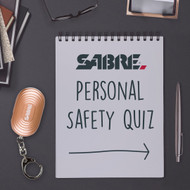SABRE Personal Safety Quiz
04 13 2025
SABRE believes Personal Safety is Personal ® and we are committed to help everyone live their lives more confidently with empowering personal safety tools, tips, and training. Are you a personal safety expert or novice? Take our personal safety quiz to find out!
Question 1
True or False: When you feel unsafe in a building it is less risky to take the stairs rather than the elevator.
A. False B. Depends C. True
Question 2
What is the minimum distance you should keep between yourself and a potential threat whenever possible?
A. 12 feet B. 10 feet C. 15 feet
Question 3
How much time do you need to assess a situation and safely avoid it?
A. 10 seconds B. 30 seconds C. 1 minute
Answers
Question 1: False
While in the event of a fire individuals should take the stairs rather than the elevator, but when the threat of a personal attack is feared, the elevator is a safer route. Stairs have many entrances and can be dark or have many hiding places for a potential attacker. Elevators have minimal entrance locations (max of 2 sides of the elevator can open), allowing you fewer opportunities to be surprised by a threat.
Additionally, elevators are equipped with emergency call systems, so if a threat is expected, you can stop the elevator and call for help in an enclosed space where a threat cannot reach you. Elevators are also much more frequented by others than stairs, so the likelihood of witnesses is greater and the time to destination is quicker.
Question 2: 12 feet
A potential attacker has the advantage since they know the attack is coming and you don’t. However, if you stay 12 feet away from strangers whenever possible, they have to take at least three steps to reach you. By taking strides towards you, they’ll raise your suspicions and give you a chance to react. Additionally, someone taking larger strides is likely to alert bystanders and other witnesses that something out of the ordinary is going on.
Question 3: 10 seconds
When arriving someplace, remember 10 seconds to safety:
Seconds 1-2: When destination is in eyesight, scan the area and determine if everything is as expected.
Seconds 3-4: When exiting a car or bus with elevated eye level, notice surroundings and determine if there are others around and analyze their behavior.
Seconds 5-6: Approach the destination and gut check if everything feels normal or if anything seems out of sorts.
Seconds 7-8: When at the doorway, scan the interior to determine if anyone or anything is out of place.
Seconds 9-10: Enter the venue and assess the environment again for any abnormalities. For example, something might be off if it's unusually quiet at a bakery at 9AM.
If you took our quiz and got mostly A’s - congrats! You're up to speed with tactics for how you can Make It Safe®. But whether you scored as a expert, novice, or apprentice, there’s always more to learn about your personal safety and maintaining your situational awareness.
For more safety tips, check out the
SABRE Personal Safety Academy or subscribe to our safety newsletter to have tips like these delivered straight to your inbox!

